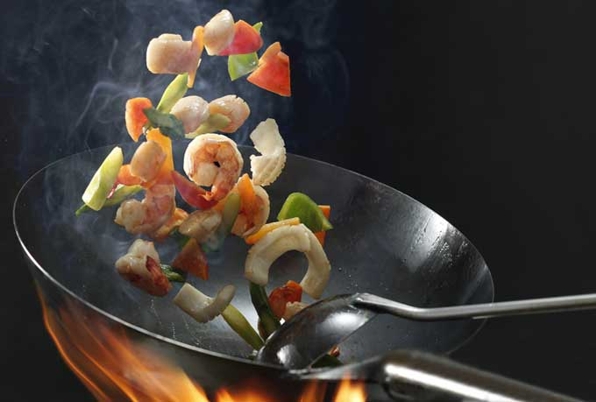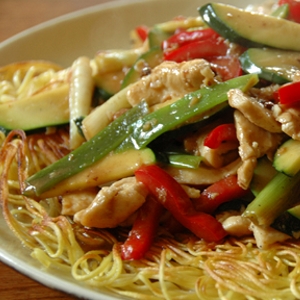Further to our recent rundown on the new Tucci cookware line… I herewith offer an update on my decade-old primer on how to make ANY pan a NON-STICK pan. This is the way professional cooks have been doing it for hundreds of years…
 Perfectly fried delicate veggies and succulent seafood in a properly-oiled pan!
Perfectly fried delicate veggies and succulent seafood in a properly-oiled pan!
The truth…
The whole truth, and nothing but the truth:
You don’t need fancy, expensive, ceramic-coated pots and pans to enjoy non-stick cooking. Just follow the time-tested, time-honoured method professional cooks have used for centuries!
How it works
There’s a simple formula. Or maybe it’s a procedure. Or maybe it’s a bit of both. But the key to stick-free cooking is this: Hot pan + cold oil = foods don’t stick.
Sounds simple, and it really is. You won’t even think about it once you’re used to using it. But there are a few nuances you’ll need to absorb into your internal cookbook before non-stick cooking becomes second-nature to you.
Fats and oils
There are many different cooking oils in use around the world. Some are suited to specific types of frying. Others are used for their flavour and texture benefits.
DON’T use solid fats
Avoid ‘white’ fats like lard and vegetable shortening. They’re notorious for smoking out, burning both your food and your pans.
Likewise, shun bacon fat or rendered ham fat. They may have great flavour, but they’ll burn, sure Hell’s a man trap!
Pure, solid butter isn’t any better. It has milk solids in it which will burn at ridiculously low temperatures, making it hard to produce perfect, un-browned eggs or other delicate foods.
In addition, solid fats all contain a lot of saturated and/or hydrogenated fats. The latter being just as bad for you dietarily as the former.
DO use clear oils
Olive oil is a great choice for most low temperature uses. Like sauetéing. But it will smoke out at the temperatures you’ll need for searing, frying or deep-frying.
Canola oil has all the qualities you’ll want for high-temperature cooking. It’s the staple oil virtually all professional chef training programs use in their kitchen labs. It’s relatively flavourless and won’t affect the flavour of your dishes. And it’s reassuringly low in price.
Sunflower, safflower, peanut and similar, more costly oils are all excellent candidates for high temperature cooking. Peanut oil is the go-to coking oil in a number of ancient and venerable Asian cuisines. The flavour of authentic, traditional Asian dishes that call for peanut oil just won’t be the same if you use something else.
As an aside: clarified, or rendered butter – from which the milk solids have been separated – can be used for all but the highest-temp pan-frying methods.
Choose the lowest temp
Choose the lowest recommended temperature for the cooking method you intend to use. That’s usually medium to medium high on the stove top. If you’re able to use an IR (non-contact) cooking thermometer, you can be more precise.
If you fry at lower-than-optimum temps, you’ll risk overcooking the exterior of the food before the interior is done. And you’ll risk the food absorbing a lot of oil, which will negatively affect flavour and mouth feel.
But in general, you should use the following temp ranges for the following cooking methods:
Pan (stove-top) frying
- Wilting: low – med low
- Sautéing: med low – med
- Delicate frying: med low – med
- General frying: med
- Shallow-frying: Med high – high
- Searing: high
Deep frying
- Should be performed at 375 F. Always use an immersible cooking thermometer for best results.
- Fry small batches to insure the oil stays hot enough for premium performance.
- And be sure to let the oil come back up to temperature before putting in the next batch of food to cook.
Wok frying
- Should be performed at 400 – 425 F. Always use a non-contact electronic thermomenter for best results.
- Always use the highest-temp oil you you can afford. Canola oil will do, but peanut oil is the optimum choice, and is less likely to break down at Wok temperatures..
- Always use a minimum amount of oil needed to keep the pan lubricated. Brush on – don’t pour – additional oil between batches or dishes. Think of it as cooking ‘on oil’ rather than ‘in oil’.
- Cook quickly keeping the food moving. Remove the food as soon as it’s done.
- Don’t add water or water-based liquids. You’ll risk a steam ‘explosion’ that can burn those at or near he stove.
Points of technique
Always fully-preheat the pan or full volume of deep-frying oil before beginning to cook.
For pan frying, always add the cold oil to the fully-preheated pan, and let it heat to the point where a drop of water dances across its surface. Or the surface of the oil begins to ‘shimmer’.
Always make sure the food you fry is surfaced-dry – at least has no visible dripping or surface water. Water will cause steam, and you’ll end up with poached or steamed food, not fried.
Always let battered or breaded foods rest for 15 min before frying. That will help ensure the batter or breading will adhere to the food.
Always use thin-sliced or julienned foods for high-temperature frying. They’ll cook faster, allowing you to avoid burning the exterior before the interior is cooked through. Just look at the way the veggies are prepped for Asian Wok-fried dishes…
And there you have it!
The latest, up-to-date, comprehensive, official Maggie J’s Complete Guide to Frying.
Go forth and sizzle!
~ Maggie J.

